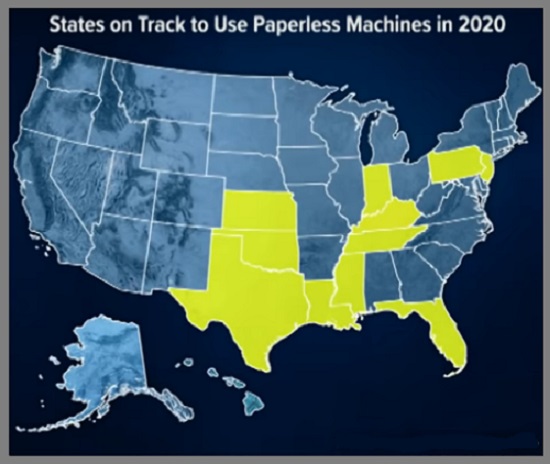Sharp increase in public
concerns about DRE machines
(DRE issue states shown in
yellow)
There are numerous ways to
create a reliable paper trail, with or without modern technologies. The most
technologically advanced method for reliable voting is the Direct-Recording Electronic (DRE) system with
an incorporated paper trail.
This system allows voters to
cast a ballot using an electronic voting machine and stores the official vote
electronically, but a receipt of the voter’s selection is also printed out.
Election officials can use
this receipt to verify that the machine counted the vote correctly and can also
use it in the case of a recount or audit following the election. Since this
system essentially creates two separate proofs of an individual’s vote, it
largely protects against electronic hacking of an election.
DREs with paper receipts are employed by 18 states, but
their cost of $5,000 per machine can be prohibitive to many others. States such as Georgia have upwards of 27,000 voting machines, and to
replace all of these currently paperless machines with the DREs with paper receipts
would cost more than $100 million.
In many states, DREs are
still not used. In their place is a classic, low-tech alternative with a modern
twist. Almost all states offer a paper ballot during their elections
that have remained similar in nature for many decades.
These paper ballots are
manually completed by voters and then scanned using optical scanner technology.
Once scanned, there is an electronic copy of the results that is typically
sufficient for reporting needs.
However, if the election is forced into a
recount or audit, the physical ballots that voters cast can be used to verify
results.
Oregon is one state that has
implemented exclusively paper voting for the past 20 years and has
noted positive benefits such as increased voter turnout. In at least one case in
2018, too, one recount in a local election actually resulted in a different
outcome than initial counts reported.
DREs with printed receipts
and paper ballots with optical scanners provide two separate options that are
both reliable. They both guard against electronic tampering with elections and
provide a method to recount or audit an election.
Although 90 percent of all states have secure and reliable
elections, even one state with vulnerable elections represents an unacceptable
weak link in an otherwise strong chain of democracy. Any voting system that lacks a paper receipt for verification purposes
is unacceptably unreliable and should be replaced with one that can verify
electronic results.
DREs with paper receipts
accomplish this goal, but for states concerned with the monetary costs of
switching to these new machines, classic paper ballots perform equally.
More DRE issues here – somewhat dated, but still applicable.
My 2 cents: More on this DRE issue from John Oliver in this segment
(about 20 minutes) in his usual funny yet serious style … here on YouTube:
November 4, 2019 show (HBO)
(Caution: His language may offend some)
(Caution: His language may offend some)
What better way to get the election results you want … stick with old
worn out systems that can’t verify the actual voting records – welcome to the
new Amerika? It’s apt to get very ugly in 2020.
Thanks for stopping by.
Thanks for stopping by.

No comments:
Post a Comment